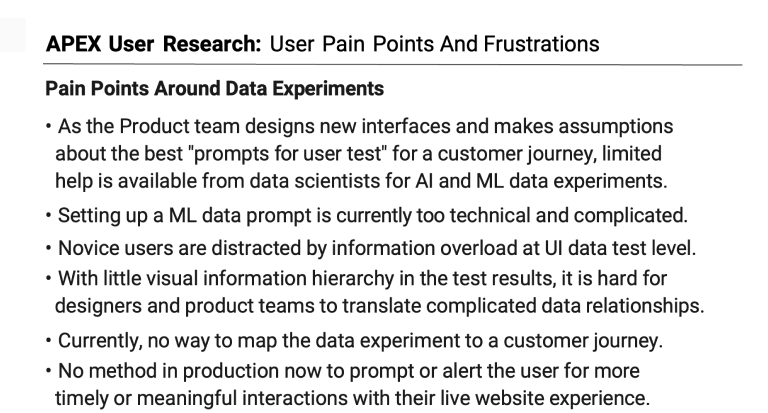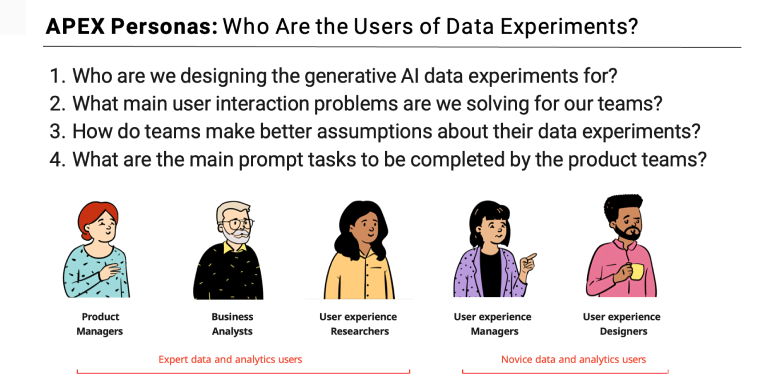Strategic User Research
My approach to user research broke away from the conventional A/B testing model,
venturing into the realm of generative AI and turnkey machine learning models. This
innovative approach was aimed at researching and deciphering the user context within
which online customers operate, focusing on identifying actionable decision variables.
Through focused analysis, my collaborative research looked for machine prompts to
determine which potential decision variables could significantly impact customer choices
and assess the current variables' effectiveness.
User Interviews: Data Scientist, Product Managers And UX Content
Designers
One of the pivotal challenges identified early in the project was the language and
conceptual barrier between the data scientists, product managers and UX content
designers. Interviews with product managers and content designers revealed a recurring
theme of misunderstanding or even unawareness of the terminologies and advanced concepts
used by data scientists, particularly around AI-driven insights.
UX Problem Areas
The investigation into the UX problem areas affecting website purchase decisions unveiled
several key challenges. Customers often encountered decision paralysis due to
overwhelming data choices or lacked personalized prompts that could guide their
decision-making process. The role of AI emerged as crucial in parsing through extensive
machine learning customer datasets to identify contextually relevant prompts that could
nudge customers towards making more informed decisions.
Synthesize And Analyze
Synthesizing the findings from user research and interviews, I analyzed the gathered data
to uncover user friction and pain points, frustrations, user patterns and actionable
insights. This process involved mapping out customer behaviors, preferences, and the
various online decision-making prompts through a process called causal diagramming. The
diagrams provided a clear picture of the optimized customer journey, highlighting areas
ripe for intervention and improvement with generative AI.
Mapping The Customer Journey
Based on the insights gleaned from research and analysis, user journey flows (causal
diagramming) were developed to represent the diverse user choices available on the
retailer's website. Journey flows were crafted to detail the typical user paths taken
through the website and identifying the “critical moments” that influence
decision-making. These tools provided a foundation for conceptualizing generative
AI-driven interventions tailored to enhance the user experience for each user personal.
Causal Diagramming
Causal diagramming was introduced by data scientist as a novel tool to visually represent
the cause-and-effect relationships inherent in the customer's decision-making process.
By mapping out the variables and events influencing purchase decisions, I was able to
identify key leverage points where generative AI interventions could make a significant
impact. This approach allowed for a deeper understanding of the complex web of factors
at play, guiding the development of targeted “event listening” algorithm solutions
within the user data.
Vision For Future AI Experience
Envisioning the future of generative AI, causal diagramming is a strategic approach used
to meticulously map data experiments onto the customer journey. This method illuminates
how different touch points, interactions, and interventions (smart prompts) impact the
overall user experience. Through this process, I gained a comprehensive understanding of
how individual components contribute to the larger narrative of the customer journey,
enabling users to make informed decisions that drive meaningful improvements across the
Best Buy digital platform.
Collaboration: Data and Product Teams
Through the strategic integration of causal diagramming, I was able to distill complex
ideas into easily digestible visuals, fostering a shared understanding among diverse
data science and product teams. This collaborative approach facilitated alignment among
internal teams and enabled us to craft a compelling narrative that resonated with
stakeholders. The causal diagrams served as concise yet comprehensive tools to convey
the intricate narrative of the customer journey.
Evaluate And Test Assumptions
The next step involved evaluating and testing the assumptions about customer behaviors
underlying the proposed AI prompt interventions. This phase utilized a mix of
qualitative feedback from users and quantitative data from AI models to refine and
validate the proposed solutions. Collaborative sessions with product managers and UX
content designers allowed for adjustments to be made on the the causal diagrams,
ensuring the final test requirements were well-tuned to customer needs.
Conclusion
This case study showcased my core technical knowledge of generative AI and machine
learning data processes, combined with innovative user research methodologies, to
enhance the online shopping experience at BestBuy. Understanding the intricate journey
of pre-purchase decision-making and its cascading impact on subsequent user behaviors
holds the key to effecting profound changes in customer interactions and steering user
journeys towards desired purchase outcomes.














